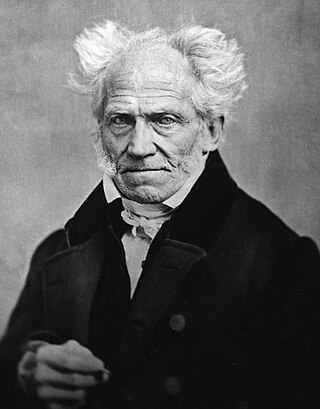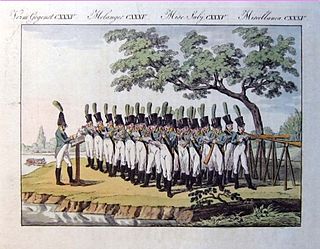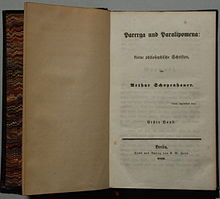Publication
In light of the unenthusiastic reception of the philosopher's earlier publications, publishers were reluctant to commit to this, his last major work. It was only after significant difficulty and through the persuasion of the philosopher's disciple Julius Frauenstädt that Hayn of Berlin consented to publish the two volumes in a print run of 750 copies—with an honorarium of only ten copies for its author. [2] [4]
Parerga and Paralipomena drew the attention of John Oxenford, a noted observer and translator of German literary culture, who contributed a favourable, albeit anonymous, review of the work for the English quarterly journal Westminster Review in 1852. [2] [4] The following year, Oxenford would write for the journal an article on Schopenhauer's philosophy entitled "Iconoclasm in German Philosophy", which, translated into German and printed in the Vossische Zeitung would spark immediate interest of Schopenhauer's work in Germany and propel the obscure figure to lasting philosophical prominence. [2] In the following years, Schopenhauer succeeded in publishing new editions of all his previous work on the strength of the revived interest, although his plans for a revised edition of Parerga and Paralipomena were stymied by the deterioration of his health in the months preceding his death in 1860. [4]

Arthur Schopenhauer was a German philosopher. He is known for his 1818 work The World as Will and Representation, which characterizes the phenomenal world as the manifestation of a blind and irrational noumenal will. Building on the transcendental idealism of Immanuel Kant (1724–1804), Schopenhauer developed an atheistic metaphysical and ethical system that rejected the contemporaneous ideas of German idealism.
In philosophy, metempsychosis is the transmigration of the soul, especially its reincarnation after death. The term is derived from ancient Greek philosophy, and has been recontextualized by modern philosophers such as Arthur Schopenhauer, Kurt Gödel, Mircea Eliade, and Magdalena Villaba; otherwise, the term transmigration is more appropriate. The word plays a prominent role in James Joyce's Ulysses and is also associated with Nietzsche. Another term sometimes used synonymously is palingenesis.
Post-coital tristesse, also known as post-coital dysphoria (PCD), is the feeling of sadness, anxiety, agitation or aggression, after orgasm in sexual intercourse or masturbation. Its name comes from Neo-Latin postcoitalis and French tristesse, literally "sadness". Many people with PCT may exhibit strong feelings of anxiety lasting from five minutes to two hours after coitus.

Transcendental idealism is a philosophical system founded by German philosopher Immanuel Kant in the 18th century. Kant's epistemological program is found throughout his Critique of Pure Reason (1781). By transcendental Kant means that his philosophical approach to knowledge transcends mere consideration of sensory evidence and requires an understanding of the mind's innate modes of processing that sensory evidence.

Arthur Schopenhauer's aesthetics result from his philosophical doctrine of the primacy of the metaphysical Will as the Kantian thing-in-itself, the ground of life and all being. In his chief work, The World as Will and Representation, Schopenhauer thought that if consciousness or attention is fully engrossed, absorbed, or occupied with the world as painless representations or images, then there is no consciousness of the world as painful willing. Aesthetic contemplation of a work of art provides just such a state—a temporary liberation from the suffering that results from enslavement to the will [need, craving, urge, striving] by becoming a will-less spectator of "the world as representation" [mental image or idea]. Art, according to Schopenhauer, also provides essential knowledge of the world's objects in a way that is more profound than science or everyday experience.

In Kantian philosophy, the thing-in-itself is the status of objects as they are, independent of representation and observation. The concept of the thing-in-itself was introduced by the German philosopher Immanuel Kant, and over the following centuries was met with controversy among later philosophers. It is closely related to Kant's concept of noumena or the objects of inquiry, as opposed to phenomena, its manifestations.

The World as Will and Representation, sometimes translated as The World as Will and Idea, is the central work of the German philosopher Arthur Schopenhauer. The first edition was published in late 1818, with the date 1819 on the title-page. A second, two-volume edition appeared in 1844: volume one was an edited version of the 1818 edition, while volume two consisted of commentary on the ideas expounded in volume one. A third expanded edition was published in 1859, the year prior to Schopenhauer's death. In 1948, an abridged version was edited by Thomas Mann.

John Oxenford was an English dramatist, critic and translator.

The hedgehog's dilemma, or sometimes the porcupine dilemma, is a metaphor about the challenges of human intimacy. It describes a situation in which a group of hedgehogs seek to move close to one another to share heat during cold weather. They must remain apart, however, as they cannot avoid hurting one another with their sharp spines. Though they all share the intention of a close reciprocal relationship, this may not occur, for reasons they cannot avoid.
Paralipomena may refer to:
Richard Clyde Taylor was an American philosopher renowned for his contributions to metaphysics. He was also an internationally known beekeeper.
Reginald John "R. J." Hollingdale was a British biographer and translator of German philosophy and literature, especially the works of Friedrich Nietzsche, Goethe, E. T. A. Hoffmann, G. C. Lichtenberg, and Schopenhauer.
"Mortal coil" is a poetic term for the troubles of daily life and the strife and suffering of the world. It is used in the sense of a burden to be carried or abandoned. To "shuffle off this mortal coil" is to die, exemplified in the "To be, or not to be" soliloquy in Shakespeare's Hamlet.
On the Basis of Morality or On the Basis of Morals is one of Arthur Schopenhauer's major works in ethics, in which he argues that morality stems from compassion. Schopenhauer begins with a criticism of Kant's Groundwork of the Metaphysic of Morals, which Schopenhauer considered to be the clearest explanation of Kant's foundation of ethics.
Christopher Janaway is a philosopher and author. He earned degrees from the University of Oxford. Before moving to Southampton in 2005, Janaway taught at the University of Sydney and Birkbeck, University of London. His recent research has been on Arthur Schopenhauer, Friedrich Nietzsche and aesthetics. His 2007 book Beyond Selflessness: Reading Nietzsche's Genealogy focuses on a critical examination of Nietzsche's On the Genealogy of Morals. Janaway currently lectures at the University of Southampton, which in the past has included a module focusing on Nietzsche's Genealogy. That module is now convened by Janaway's colleague, Aaron Ridley.

On the Fourfold Root of the Principle of Sufficient Reason is an elaboration on the classical principle of sufficient reason, written by German philosopher Arthur Schopenhauer as his doctoral dissertation in 1813. The principle of sufficient reason is a powerful and controversial philosophical principle stipulating that everything must have a reason or cause. Schopenhauer revised and re-published it in 1847. The work articulated the centerpiece of many of Schopenhauer's arguments, and throughout his later works he consistently refers his readers to it as the necessary beginning point for a full understanding of his further writings.

Untimely Meditations, also translated as Unfashionable Observations and Thoughts Out of Season, consists of four works by the philosopher Friedrich Nietzsche, started in 1873 and completed in 1876.

The Art of Being Right: 38 Ways to Win an Argument is an acidulous, sarcastic treatise written by the German philosopher Arthur Schopenhauer. In it, Schopenhauer examines a total of thirty-eight methods of defeating one's opponent in a debate. He introduces his essay with the idea that philosophers have concentrated in ample measure on the rules of logic, but have not engaged with the darker art of the dialectic, of controversy. Whereas the purpose of logic is classically said to be a method of arriving at the truth, dialectic, says Schopenhauer, "... on the other hand, would treat of the intercourse between two rational beings who, because they are rational, ought to think in common, but who, as soon as they cease to agree like two clocks keeping exactly the same time, create a disputation, or intellectual contest."
On Vision and Colors is a treatise by Arthur Schopenhauer that was published in May 1816 when the author was 28 years old. Schopenhauer had extensive discussions with Johann Wolfgang von Goethe about the poet's Theory of Colours of 1810, in the months around the turn of the years 1813 and 1814, and initially shared Goethe's views. Their growing theoretical disagreements and Schopenhauer's criticisms made Goethe distance himself from his young collaborator. Although Schopenhauer considered his own theory superior, he would still continue to praise Goethe's work as an important introduction to his own.

The Russian horn orchestra flourished as a distinct music genre in 18th and 19th century Russia. It was a coordinated performance using hunting horns known as Rozhoks, each of which could produce only one specific sound.











